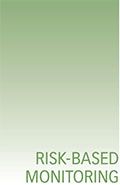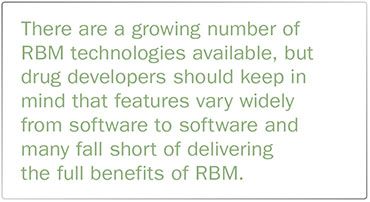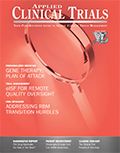Tackling the Challenges of Transitioning to RBM
Applied Clinical Trials
Methods sponsors and CROs can use to minimize the growing pains associated with RBM implementation.

In today’s competitive clinical trial environment, sponsors and contract research organizations (CROs) are under intense pressure to move drug candidates safely and efficiently through clinical trials. Adoption of a risk-based monitoring (RBM) approach can help enhance the safety and efficiency of clinical trials, while automating labor-intensive data analysis and improving data quality. As the FDA encourages drug developers to integrate digital technologies into the development process, biopharmaceutical companies are increasingly turning to automated clinical trial software solutions that incorporate RBM.
Dynamics accelerating the trend toward RBM
RBM has garnered attention among the clinical research community since the FDA published its industry guidance, “Oversight of Clinical Investigations – A Risk-Based Approach to Monitoring” in August 2014. In the intervening years, though, adoption has been slow and implementation has been challenging.
With the recent update to the ICH Guidelines for Good Clinical Practice and the FDA’s draft guidance on “A Risk-Based Approach to Monitoring of Clinical Investigations Questions and Answers,” which was published in April 2019, regulatory focus on RBM has intensified. In fact, RBM has emerged as the standard for clinical monitoring.
Other factors are also accelerating the trend toward RBM. Industry-side emphasis on modernizing and optimizing the efficiency of clinical trials is driving digitization of the development process, from recruitment and data collection to adherence and data analysis. Further, the push toward precision medicine and biomarker-guided drug development has led to an increase in the volume and complexity of data generated by clinical trials. With nearly 80% of data scientist time spent collecting, cleaning, and organizing data sets, there is a strong demand for automated solutions.
Overcoming five challenges of transitioning to RBM
RBM technology is an automated solution that can help sponsors and CROs implement comprehensive monitoring strategies from a single platform with built-in workflows and advanced analytic capabilities. As RBM software solutions evolve to keep pace with the rest of the clinical trial landscape, it can be overwhelming for sponsors and CROs to make the transition to RBM. Here, we’ve outlined five key challenges associated with adopting an RBM approach and how they can be addressed to ensure a smooth transition.
1. Resistance to change
Embracing the concept of RBM requires a shift in mindset from traditional monitoring, and drug developers may feel cautious of, or resistant to, this change. This may be due, in part, to uncertainty about how the FDA will respond to the use of RBM techniques. However, sponsors and CROs should also consider how regulatory agencies might respond if RBM modifications are not made. For companies who are uncomfortable making the shift to RBM, a useful exercise would be to evaluate the factors fueling that hesitation and figure out how to address them.
Even for companies that are ready to transition to RBM, the change can be daunting and proactive change management is essential. The move toward an RBM approach requires change management related to people, process, and technology. Commitment at the leadership level, along with staff training and a clear understanding of each team member’s roles and responsibilities, helps ensure that RBM is incorporated into the DNA of both the company and the clinical trial.
2.Lack of proactive planning
As the saying goes, if you fail to plan, you plan to fail. Implementation of an RBM approach requires proactive planning. Once an organization is ready to transition to RBM and key stakeholders have been identified, the following steps should be taken:
- Identify critical data and processes. What data and processes are critical to ensuring patient safety and study integrity?
- Perform a risk assessment. Identify, analyze, and prioritize risks, and then determine whether those risks need to be modified by implementing controls.
- Develop a monitoring plan. A comprehensive monitoring plan should focus on preventing or mitigating the most important or likely risks to critical data and processes.
3. Selecting the right RBM technology

There are a growing number of RBM technologies available, but drug developers should keep in mind that features vary widely from software to software and many fall short of delivering the full benefits of RBM. Some RBM technologies only look at risk in isolation, without context or analysis. Others may be limited by their reliance on retrospective data, missing the critical capability to draw insight from emerging issues or placing undue emphasis on irrelevant historical information. An incomplete approach to identifying, managing, and analyzing risk introduces complexity and cost without adding value. Moreover, a system that fails to fully assess risk could also introduce a new risk: a false sense of security. Sponsors and CROs may mistakenly believe that they are utilizing RBM, without fully benefiting from all that RBM can offer.
A comprehensive RBM technology approaches risk from all angles-operational, safety, and quality. The following are factors to consider when evaluating an RBM software platform:
Risk identification and assessment. Check that the system allows users to identify and log critical data and processes relevant to the study. The system should also enable users to assess and characterize risk at study start-up and throughout the course of the study.
Risk control and mitigation. Verify that the RBM technology has the ability to control and mitigate each of the risks identified through a variety of risk management strategies. These risk management strategies may be automated or manual. For example, can the software issue alerts when risks approach pre-defined thresholds and when safety or data quality is at risk of compromise?
Risk communication and action. Determine if the RBM technology allows for streamlined, centralized review of the risks detected through statistical models, intuitive data visualization, and the ability to drill down into the data (e.g., by geography, site, patient, or type). Ideally, the software should also give users the ability to act on and close out risks through automated workflows and ticketing functionality.
Risk review and updating. Finally, confirm that the RBM software allows for regular and ongoing review and modification of risks. This helps sponsors and CROs ensure that risk management activities remain effective and take into account emerging knowledge and experience.
RBM technology that delivers all of these capabilities can truly empower sponsors and CROs to conduct trial monitoring efficiently, while simultaneously enhancing patient safety and data quality.
4. Uncertainty about implementation
As clinical trials become more complex, RBM technologies have also become more sophisticated. Thoughtful implementation is the first step in unlocking the full value of RBM technology. However, there is no “one-size-fits-all” approach to RBM and implementation must be customized to the sponsor and the study.
The process of implementation involves requirements gathering, planning, and testing, and should cover five key areas:
Project scope. Ensure the scope aligns with the needs of the end user(s) and includes clear definitions of roles and responsibilities. Sponsors may benefit from starting with a pilot of the technology, which allows them to familiarize themselves with the implementation process, test the system, and validate internal processes on a small scale.
SOP/plan impact. Review existing procedures and plans, and update them or create new processes, if necessary. This is also an opportunity to document how issues identified by the system will be escalated internally.
Communication. Document how the sponsor will communicate with both the technology vendor and the end user(s).
User acceptance testing (UAT) plan. This is an area many sponsors overlook. Perform UAT at both the system level and the study-specific level to ensure seamless integration.
Oversight plan. Outline not only how success and value will be measured, but also how these metrics will be communicated to all stakeholders.
5. Lack of appropriate resources
The key stakeholders driving the transition to RBM will come from multiple departments within an organization, from clinical operations, data management, and safety, to IT, training, statistics, and regulatory. Typically, the implementation team will include the following stakeholders:
Owner/drivers. These are the people who will own and drive the implementation process.
Decision-makers. These are the stakeholders who will make decisions on how the RBM technology is implemented.
Subject matter experts. These are the people who have the right background and skillset to advise on the implementation that makes the most sense for a particular study.
Users. These are the stakeholders who will be utilizing the RBM technology during the course of a clinical trial. Considering the needs and requirements of end users in the early stages of implementation ensures that the system is being set up in a way that is most useful, efficient, and cost-effective post-implementation.

Given the cross-functional, multi-disciplinary team required for a successful RBM implementation, some sponsors and CROs may have resource or knowledge gaps within their organizations. For companies that are considering integrating RBM into their organizations, there are a variety of external resources, ranging from online training to risk/quality management consultants and RBM software vendors, that can help them navigate the decisions needed for a successful RBM technology implementation.
Taking advantage of the benefits of RBM technology
A common misconception is that primary goals of RBM are to reduce source document verification (SDV) and decrease the frequency of on-site monitoring visits. In reality, RBM is part of a broader trend toward risk-based quality management, which encompasses the entire ecosystem of processes sponsors put in place to identify, assess, control, communicate, and review the risks associated with a clinical trial. Within this larger context, RBM technology is software that:
- Provides visibility into an entire study, allowing stakeholders to manage and mitigate risks, and provides a clear audit trail.
- Enables consistent communication across the entire team.
- Provides ongoing oversight of patients, sites, and the study as a whole to facilitate informed decision-making (e.g., percentage of SDV required, frequency of on-site monitoring visits, safety, site performance, etc.).
Implementation of RBM has the potential to bring a number of measurable benefits:
Automation. Some RBM technologies utilize machine learning to alert stakeholders and decision-makers about potential risks that may have been overlooked during trial set-up. By analyzing data collected during the trial on a prospective basis, these technologies can identify patterns and anomalies.
Improved patient safety and data quality. RBM technology provides notifications when issues are identified at the patient-, site-, or study-level. By continuously tracking trend information and making actionable data readily available, RBM technology enables sponsors and CROs to take corrective action in a timely fashion, improving both patient safety and data quality.
More effective on-site monitoring. Apart from investigator fees, clinical monitoring is the largest driver of clinical trial costs, accounting for over 60% of study-related labor costs. With RBM analytics, on-site visits are triggered by study-specific risk thresholds-rather than being performed on a pre-defined schedule-which may lead to reduced, but more effective, on-site monitoring.
Efficiency. Data cleaning at the end of a study can be extremely time-consuming. Implemented correctly, RBM can help shorten the timelines for evaluating study data. RBM technology evaluates data on an ongoing basis, which can help reduce the time from the end of the study to the reporting of study results.
Compliance. Regulatory agencies are demanding more robust assurances of patient safety and data quality. Drug developers who leverage an RBM technology with traceability and audit capabilities are well-equipped to meet current and emerging regulatory requirements.
Getting started
With a combination of proactive planning and the right people, processes, and technology, sponsors and CROs can minimize the growing pains associated with RBM implementation. Investing time in getting an RBM technology implementation right enables drug developers to leverage this automated solution to manage risk, facilitate communication, and get the insights they need to make informed decisions, all at their fingertips.
Crystal Stone is Risk-Based Monitoring Senior Product Specialist, Remarque Systems; Amanda Coogan is Risk-Based Monitoring Product Specialist, Remarque Systems

Improving Relationships and Diversifying the Site Selection Process
April 17th 2025In this episode of the Applied Clinical Trials Podcast, Liz Beatty, co-founder and chief strategy officer, Inato, discusses a number of topics around site engagement including community-based sites, the role of technology in improving site/sponsor relationships, how increased operational costs are impacting the industry, and more.
Behind the Buzz: Why Clinical Research Leaders Flock to SCOPE Summit
February 7th 2025In this episode, we meet with Micah Lieberman, Executive Conference Director for SCOPE Summit (Summit for Clinical Ops Executives) at Cambridge Innovation Institute. We will dive deep into the critical role of collaboration within the clinical research ecosystem. How do we bring together diverse stakeholders—sponsors, CROs, clinical trial tech innovators, suppliers, patients, sites, advocacy organizations, investors, and non-profits—to share best practices in trial design, program planning, innovation, and clinical operations? We’ll explore why it’s vital for thought leaders to step beyond their own organizations and learn from others, exchanging ideas that drive advancements in clinical research. Additionally, we’ll discuss the pivotal role of scientific conferences like SCOPE Summit in fostering these essential connections and collaborations, helping shape the future of clinical trials. Join us as we uncover how collective wisdom and cross-industry partnerships are transforming the landscape of clinical research.